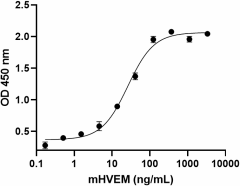- Regulatory Status
- RUO
- Other Names
- Herpesvirus Entry Mediator, HVEA, TR2, Tumor Necrosis Factor Receptor Superfamily 14, TNFRSF14

-

When mouse BTLA is immobilized at 1.0 µg/mL, mouse HVEM binds in a dose dependent manner with EC50 of 15 - 60 ng/mL.
| Cat # | Size | Price | Quantity Check Availability | ||
|---|---|---|---|---|---|
| 771302 | 10 µg | $47.00 | |||
| 771304 | 25 µg | $106.00 | |||
| 771306 | 100 µg | $282.00 | |||
HVEM (Herpes virus entry mediator), also known as TNFRSF14, is a member of the tumor necrosis factor (TNF) receptor family that mediates herpes virus entry into cells during infection. Upon overexpression, HVEM activates NF-κB and AP-1 through a TNF receptor-associated factor (TRAF)-mediated mechanism. HVEM ligands belong to two distinct families: the TNF-related cytokines LIGHT and lymphotoxin-α, and the Ig-related membrane proteins BTLA and CD160. HVEM and its ligands have been involved in the pathogenesis of various autoimmune and inflammatory diseases, tumor progression and resistance to immune response. It has been demonstrated that HVEM induces a novel signaling pathway downstream leading to signal transduction and activation of STAT3 in epithelial cells. Since STAT3 regulates the expression of genes important for host defense in epithelial cells, as well as the differentiation of retinoid-related orphan receptor RORγt+, Th17, and innate lymphoid cells. This finding suggests that HVEM may play an important role in mucosal host defense.
Product Details
- Source
- Mouse HVEM, amino acids Gln39-Val307 (Accession # Q71F55) with a C-terminal human IgG1 Fc and 6-His tag was expressed in 293E cells.
- Molecular Mass
- The 413 amino acid recombinant protein has a predicted molecular mass of approximately 45.9 kD. The DTT-reduced protein migrates at approximately 55 kD and and non-reduced protein migrates at approximately 110 kD by SDS-PAGE. The predicted N-terminal amino acid is Gln.
- Purity
- > 95%, as determined by Coomassie stained SDS-PAGE.
- Formulation
- 0.22 µm filtered protein solution is in PBS, pH 7.2
- Endotoxin Level
- Less than 1.0 EU per μg protein as determined by the LAL method.
- Concentration
- 10 and 25 µg sizes are bottled at 200 µg/mL. 100 µg size and larger sizes are lot-specific and bottled at the concentration indicated on the vial. To obtain lot-specific concentration and expiration, please enter the lot number in our Certificate of Analysis online tool.
- Storage & Handling
- Unopened vial can be stored between 2°C and 8°C for up to 2 weeks, at -20°C for up to six months, or at -70°C or colder until the expiration date. For maximum results, quick spin vial prior to opening. The protein can be aliquoted and stored at -20°C or colder. Stock solutions can also be prepared at 50 - 100 µg/mL in appropriate sterile buffer, carrier protein such as 0.2 - 1% BSA or HSA can be added when preparing the stock solution. Aliquots can be stored between 2°C and 8°C for up to one week and stored at -20°C or colder for up to 3 months. Avoid repeated freeze/thaw cycles.
- Activity
- When mouse BTLA is immobilized at 1.0 µg/mL, mouse HVEM binds in a dose dependent manner with EC50 of 15 - 60 ng/mL.
- Application
-
Bioassay
- Application Notes
-
BioLegend carrier-free recombinant proteins provided in liquid format are shipped on blue-ice. Our comparison testing data indicates that when handled and stored as recommended, the liquid format has equal or better stability and shelf-life compared to commercially available lyophilized proteins after reconstitution. Our liquid proteins are verified in-house to maintain activity after shipping on blue ice and are backed by our 100% satisfaction guarantee. If you have any concerns, contact us at tech@biolegend.com.
- Product Citations
-
Antigen Details
- Distribution
-
Spleen, thymus, lung, macrophages, B cells and T cells.
- Function
- HVEM plays a role in mucosal host defense, autoimmune and inflammatory diseases, and tumor progression.
- Ligand/Receptor
- BTLA, CD160, LIGHT, lymphotoxin-α
- Bioactivity
- Measured by its ability to bind mouse BTLA
- Biology Area
- Cell Adhesion, Cell Biology, Immunology, Signal Transduction
- Molecular Family
- Adhesion Molecules, CD Molecules, Immune Checkpoint Receptors, Soluble Receptors
- Antigen References
-
- Pasero C. et al. 2012. Curr. Opin. Pharmacol. 12:478.
- Hsu H. et al. 1997. J. Biol. Chem. 272:13471.
- Mauri DN. et al. 1998. Immunity. 8:21.
- Montgomery R.I. et al. 1996 Cell. 87:427.
- Shui J.W. et al. 2012. Nature. 488:222.
- Gene ID
- 230979 View all products for this Gene ID
- UniProt
- View information about HVEM on UniProt.org
